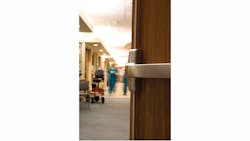"Quiet" is very important in healthcare facilities and provides an excellent opportunity for locksmiths to show equipment to them. In areas used for patient care and staff concentration, the overall reduction of auditory disturbances is very important. Without question, the clanking and banging associated with mechanical push pads on exit devices can be an annoyance to patients and staff, who both need peace and quiet. Doors with electric latches can also produce a lot of noise, especially at night when patients are trying to sleep. Hearing that KLUNK every time someone uses a doorway can become extremely irritating and actually delay healing time.
Specially designed, low energy quiet latches with dB levels as low as 55dB and sound reducing exit devices can help. By incorporating exit devices with innovative dampers that decelerate the mechanical push pads on the push and return stroke and motor-driven electronic latches, most of the noise associated with traditional exit devices is eliminated. Also, using a concealed vertical cable system eliminates the rattles and clanking of rods in the door on the frame.
Additionally, modular electric latch conversion kits let hospitals upgrade their current exit devices to the new, quieter versions without buying a whole new device. This design allows hospitals to more easily provide a quieter environment for their patients and staff.
Quiet Equipment Options
Instead of using traditional rod-based exit devices, consider those using a concealed vertical cable system. These exit devices are a much quieter solution over standard surface or concealed rods. Enclosed cable-based exit devices are a much quieter solution because they do not lift up and down with a clang.
Hospitals can also install pneumatic controlled exit devices. The pneumatic latch retraction solution provides efficient latch retraction using compressed air. It is available on non-electrified panic and fire exit hardware. Heavy-duty rubber door silencers can also be easily affixed to the door frame, acting as a sound absorber. When the door is closed, the silencers absorb the force generated from closing the door, making it virtually silent.
Door accessories make the opening safer and more accessible, as well as quieter. Hinges that swing clear, combined with a wider patient room door, provide extra clearance, making it easier for staff to maneuver heavy and sometimes bulky equipment that create noise going in and out of the room. Push/pull latches are easy to use and can be operated by a hip or elbow, again reducing the noise of banging a carried object into the door in order to open it. Lastly, door silencers do exactly what their name implies.
Cutting Cross Corridor Noise
Hospital personnel need easy movement throughout the facility and don’t like to open doors or wait for them to open when they’re in a hurry. Doors that don’t open as needed can sustain repeated damage from carts and other equipment banging into them. A smart solution is to automate the hospital’s cross corridor openings which will also reduce noise.
To automate them with enough time for easy flow of traffic, locate a push or touchless actuator farther than from the door opening. By creating a longer distance between the actuator and the door, it lets the user trigger the actuator sooner with the result that a door is open by the time the user gets to it, minimizing damage and noise from pushing. Wireless actuator options talk directly to the auto-operators and make installation simpler.
Remember, today’s healthcare facilities are evaluated not only for their ability to provide effective medical treatment but also by how peaceful they can make the environment for patient recoveries. Door hardware that is quiet can be one of the tools that provide a more restful and beneficial hospital stay.
Ann Timme is Allegion's Healthcare Marketing Manager






